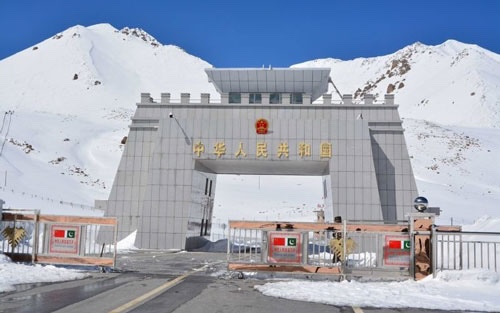CPEC: Challenges in the Post-US withdrawal Geopolitical Scenario | By Col (R) Muhammad Hanif

THE China-Pakistan Economic Corridor (CPEC) is China financed mega connectivity project, involving China’s investment of over US $ 60 billion, comprising the construction of motorways/roads, railways, air, sea and dry ports, and laying of the fibre optic in Pakistan to connect the Kashgar city of Xinjiang autonomous region of China with the Gwadar port of Pakistan.
The CPEC also includes the construction of electricity generation plants and industrial zones in Pakistan, and industrial and agricultural cooperation between China and Pakistan.
The CPEC is an investment and trade oriented economic undertaking, and a pilot project of the China’s Bridge and Road Initiative (BRI)), which is part of Chinese President Xi Jinping’s concept of the shared development and destiny of China’s neighbours and the world countries at large, as the BRI covers many continents and regions of the world.
This concept is based on enhancing the connectivity and economic development of CPEC member countries through China’s economic investment, which will help enhance mutual economic growth and trade to kill poverty and bring prosperity to all.
The construction of the CPEC had started in 2015, after the CPEC agreement was signed between China and Pakistan during President Xi Jinping’s visit to Pakistan, the same year.
The CPEC based Chinese investment is a great opportunity for Pakistan’s economic development, which came at a time when no other major economic power in the world had offered to make such a huge investment in Pakistan.
Hence, the completion of the CPEC is a necessity for enhancing Pakistan’s economic growth and increasing its forex reserves through CPEC-based trade benefits and exports, end poverty, pay Pakistan’s huge foreign debt and to make it an economically strong and sovereign country.
As part of the CPEC, many projects have already been completed in Pakistan, due to which electricity load shedding has drastically reduced and businesses are flourishing and the domestic connectivity and inland trade activities have multiplied.
Also, container-based international trade to China, Pakistan and Afghanistan by using the Gwadar port has already started.
Hence, Pakistan considers the CPEC as a purely economic-oriented project which must be completed on time to draw maximum economic benefits, and its opposition by some countries is just meant to undermine Pakistan’s economic development.
So far, the development of the CPEC has gone quite smoothly as the TPP-related terrorism in Pakistan was totally defeated by the Pakistan military, and the India sponsored terrorism in Pakistan using the Afghan soil and TPP and other terrorist groups based in Afghanistan was also well checked by the Pakistan Army.
However, as the US President Biden has announced that all the US/NATO troops in Afghanistan will leave that country by 11 September 2021 to implement the US-Taliban Peace Accord-2020, and the Ghani Government-Taliban talks have not progressed, in view of Afghanistan’s likely instability, the construction of the CPEC may face some new challenges.
Also, President Biden’s recent announcement in the G-7 summit forum on 12 June 2021 that the G-7 countries should jointly counter China’s BRI project by providing an alternative to the affected countries may also have some negative implications for the CPEC.
To be more specific, the post-US withdrawal geopolitical situation in South Asia and in the world may bring the following challenges for the development and use of the CPEC.
If the Ghani Administration continues to use delaying tactics in the talks with the Taliban and no peace agreement is signed within a reasonable time frame, internal fighting will start and Afghanistan will become more unstable.
The situation will be further complicated if the US/NATO countries start supporting the Ghani government forces by launching airstrikes against the Taliban by using their military bases located in other countries, although they will not ultimately succeed in keeping the Ghani Government in power for more than one or two years.
While the above-mentioned instability in Afghanistan will encourage India sponsored terrorism in Pakistan using the Afghan soil, it might also pose a threat to the manpower working on the CPEC, and a challenge for the Pakistan military to neutralize the threat.
Also CPEC’s progress to connect with the Central Asian Republics (CARs) through Afghanistan is likely to suffer.
The situation can get complicated if to dent China’s BRI, the US also starts pressuring Pakistan to compromise on the CPEC, being the pilot project of the BRI, as India will be encouraged to use the Afghan soil to destabilize the CPEC.
In view of the above challenges, the following should be Pakistan’s priorities. It should use its influence with the Afghan Government and the Taliban for the success of the peace process to bring stability to Afghanistan.
If the Ghani government continues to delay the peace process for too long, and infighting continues, Pakistan should remain neutral, but alert to face threats to the development of the CPEC.
Finally, the Taliban are likely to succeed in taking over Afghanistan militarily within one to two years and peace will prevail.
In the process, Pakistan should not be deterred by any US pressures on the CPEC, as it will just be a temporary phase, since the US will not like to break its relations with Pakistan, as it needs it for the peace and stability in South and Central Asia and also in the Middle East and the Muslim world.
Moreover, Pakistan can also act as a mediator to reduce tension between the US and China.
In this context, Pakistan should also make efforts to have a meaningful dialogue with the US to reset its relations with the superpower, without compromising on its relations with China.


